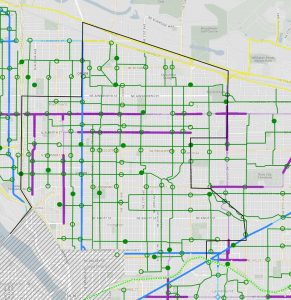Let no one say that Terry Dublinski-Milton lacks vision.
The advocate for better neighborhood greenways — back in 2012, before he teamed up with BikeLoudPDX, the Southeast Uplift neighborhood coalition and other groups, he founded a niche greenway advocacy campaign called C.O.P.I.N.G. with Bikes — unveiled a map yesterday of what it’d look like if traffic diversion were required “at or near every greenway crossing of a neighborhood collector, corridor or civic corridor” in inner northeast Portland.
Neighborhood greenways are low-traffic, low-stress side streets, mostly developed in Vancouver BC and Portland, that have become the backbone of Portland’s biking network. The city has long used diverters to reduce auto traffic on a a street; last year it created formal guidlines for determining when to install a diverter to keep auto traffic on a neighborhood greenway below 2,000.
Dublinski-Milton — a man whose initials of “TDM” happen to stand for the concept of transportation demand management, “the application of strategies and policies to reduce travel demand, specifically that of single-occupancy private vehicles” — isn’t a fan of those guidelines. He feels they’ve given the city a rationale for not installing diverters when it could.
Advertisement

(Photo: J Maus/BikePortland)
Key: Green=Greenways Yellow=Collector streets Purple=Neighborhood commercial corridors and Blue are the BIG corridors like Sandy or MLK.
The Solid green circles are built diverters or paths that act like ones. The open circles are diverters that would be built as part of the policy I was presenting on last night.
I am not only proud of my presentation….but look at the fucking cool map I made! It is only about a total of 100 diverters throughout the NE Coalition, but I think it would be a great start to building out a safe, and robust greenway system.
It’s a provocative concept for sure. Back in 2010, when the city started investing in neighborhood greenways in a big way, they were seen as the best way to start building the Bicycle Plan for 2030 because they were so noncontroversial. Once a greenway network was built, the theory went, there would be more people riding, and that would create the political support necessary to put protected bike lanes on major commercial streets, connecting the rest of the network.
Six years later, building out the neighborhood greenway network has stalled, though it could get a new boost of energy if next month’s gas tax passes. Recent bike counts suggest that (after several years’ delay) the greenway network may have finally started creating new bike users.
Dublinski-Milton definitely doesn’t oppose protected bike lanes on major commercial streets (which hasn’t made significant progress either) but he’s chosen to focus his activism on further improving the greenway network. If he could win supporters for that plan in city government and other institutions, that’d be an interesting and unexpected strategic shift for local bike advocacy — but not the first.
— Michael Andersen, (503) 333-7824 – michael@bikeportland.org
Our work is supported by subscribers. Please become one today.



